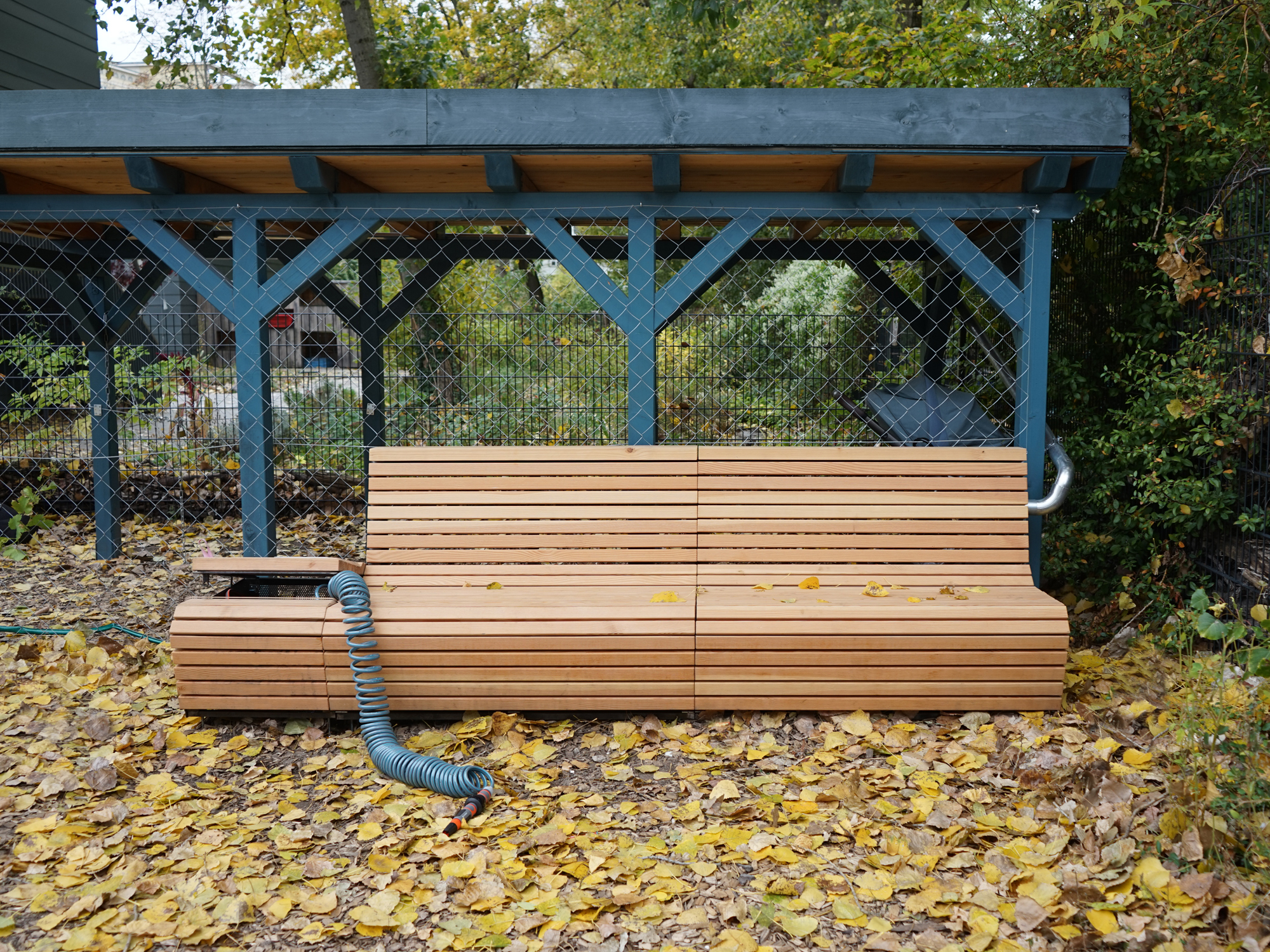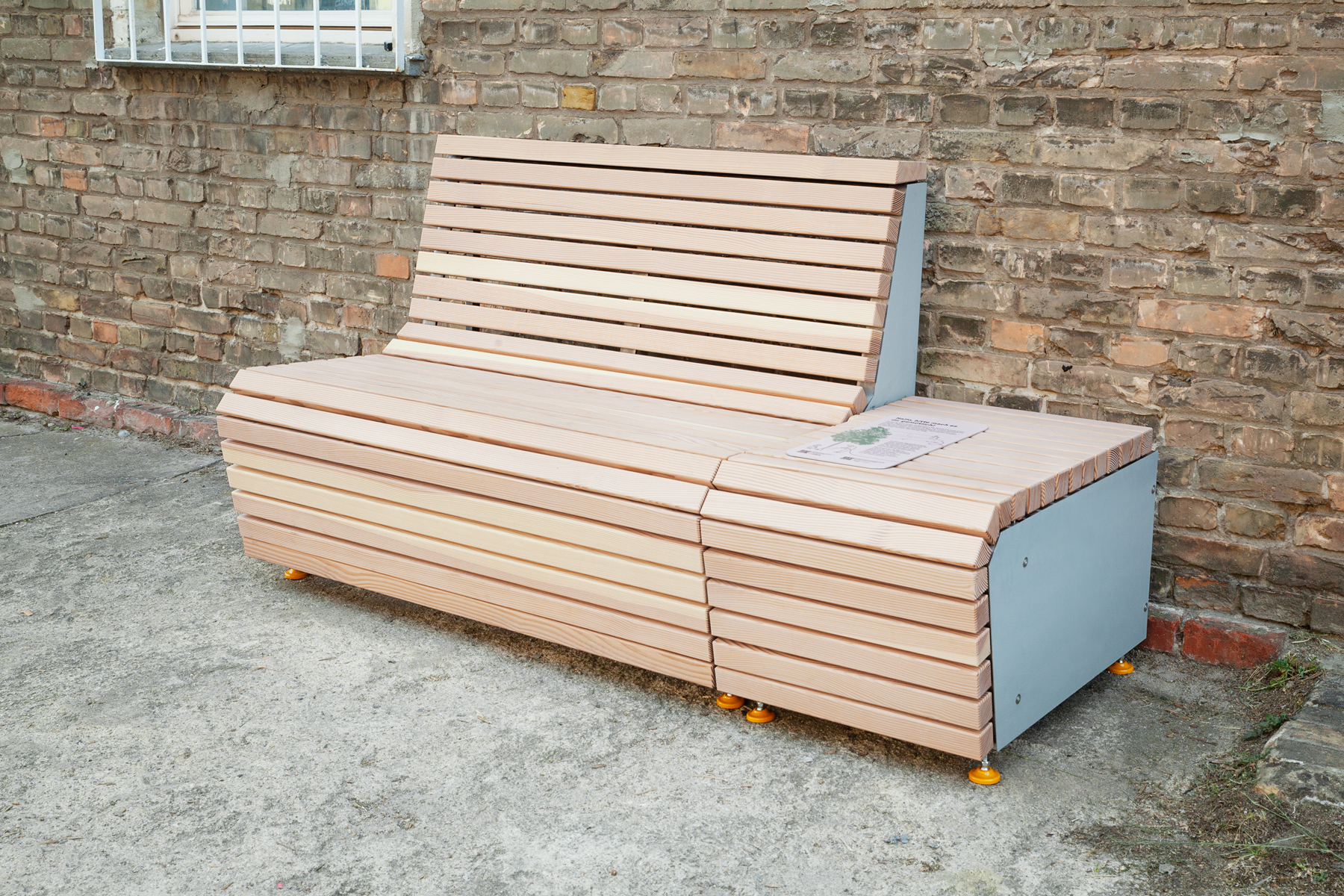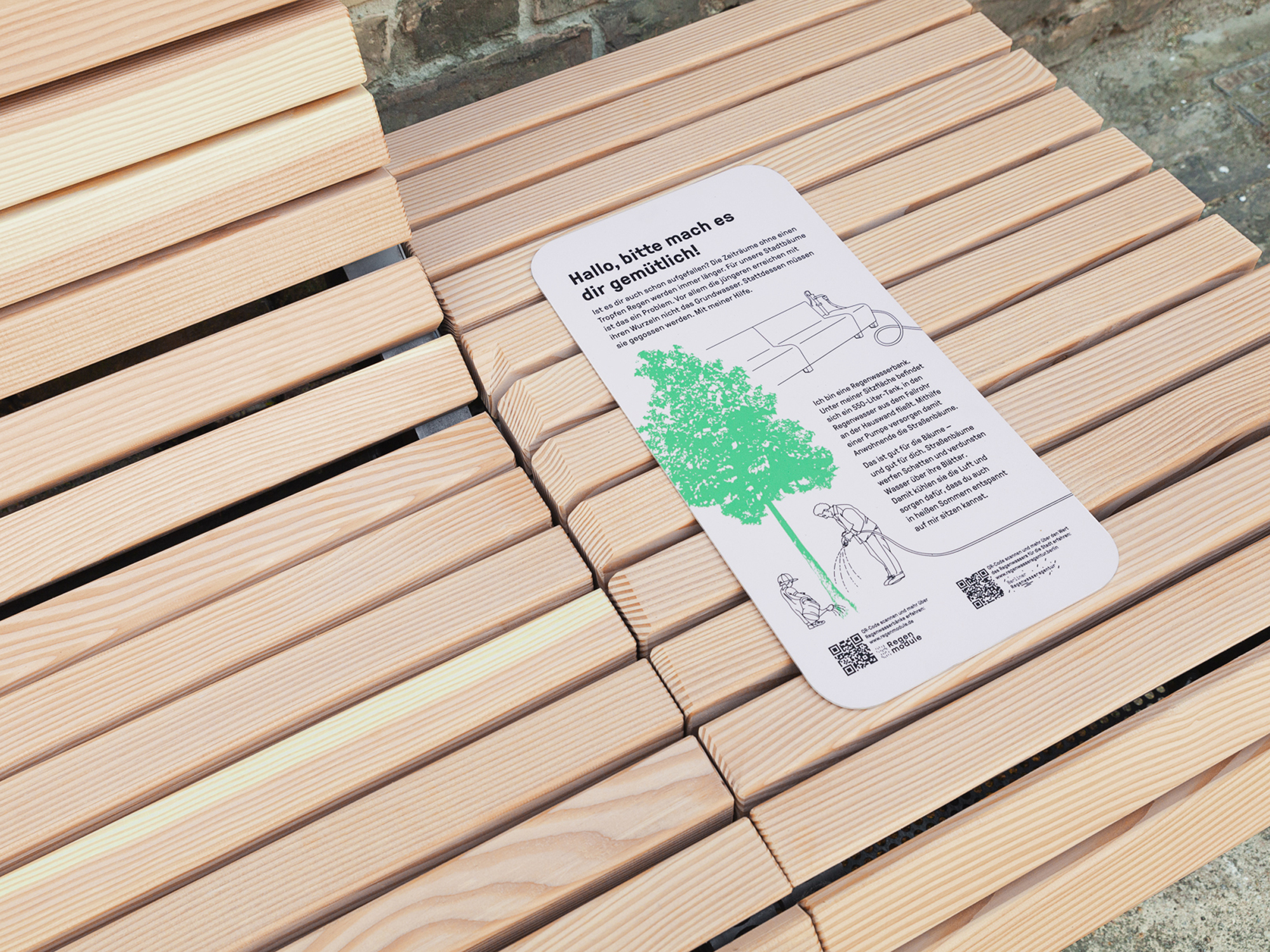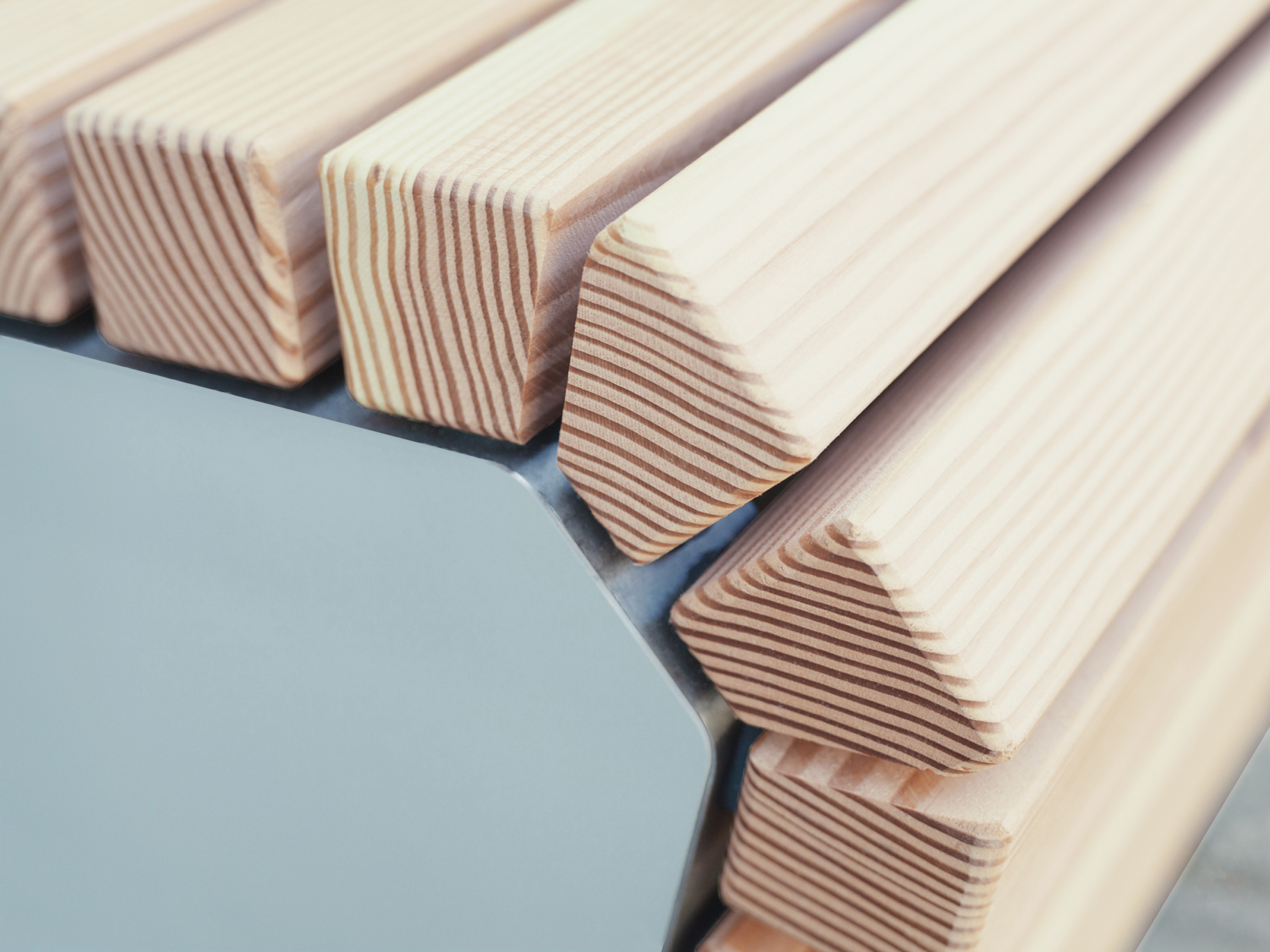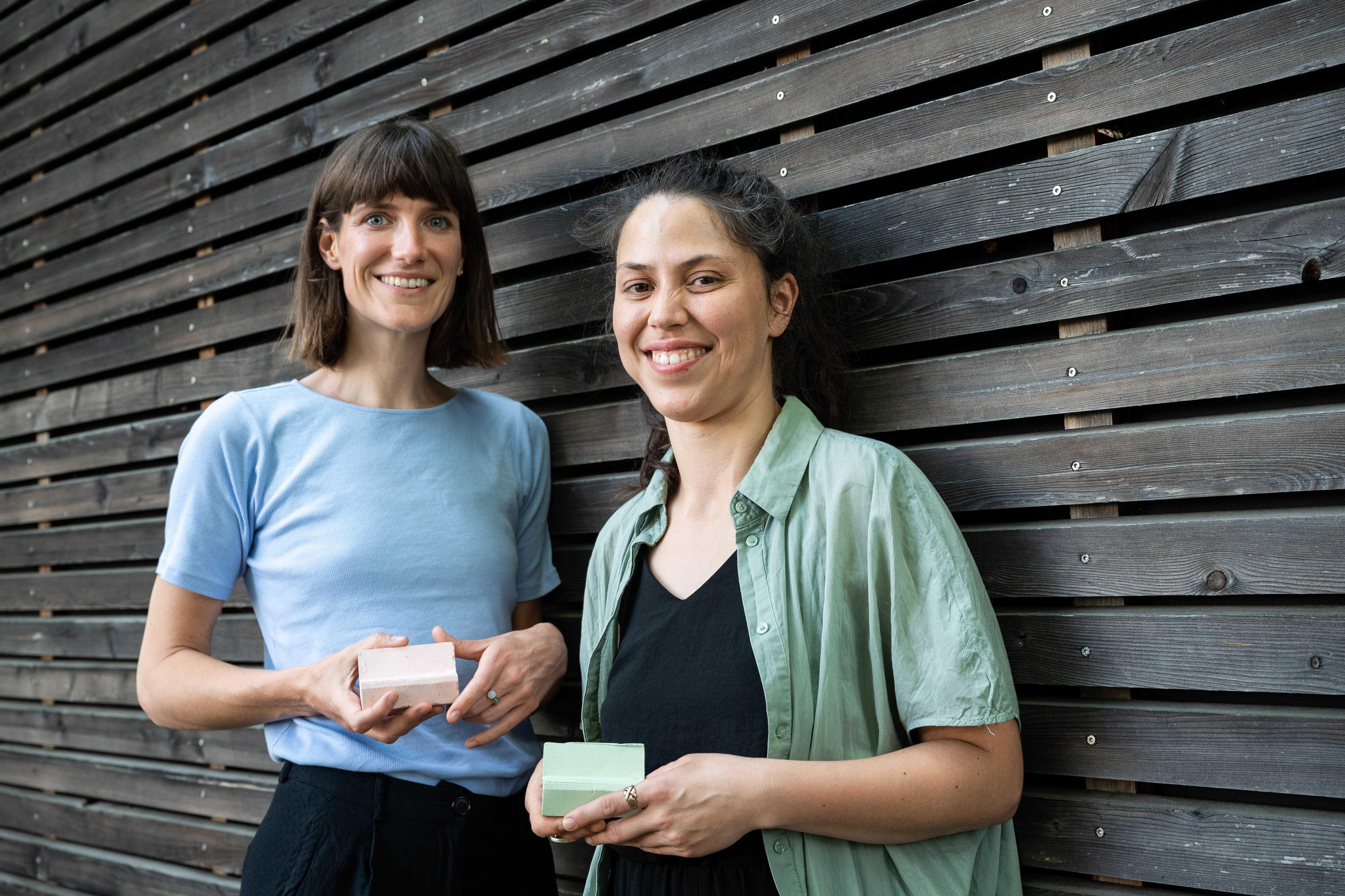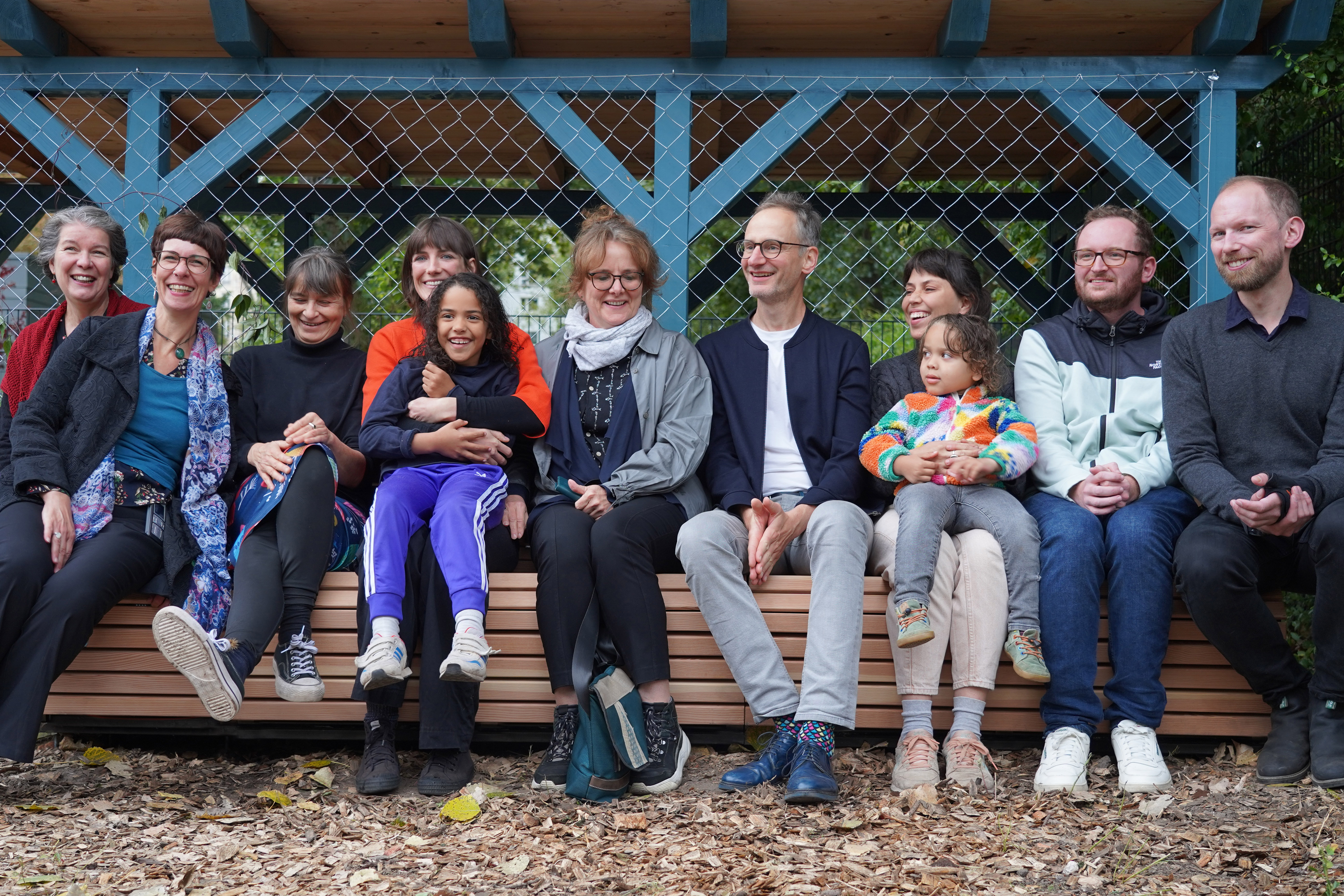Reconnecting with nature
The first Rainwater Bench by Regenmodule
A Multifunctional Urban Furniture finds its Way to its first location
What started as the idea of an urban ecologist and a furniture designer has turned into a real project within a year. With the invention of the "rainwater bench," a story began that not only led to the creation of a multifunctional urban piece of furniture for the sponge cities of the future but also to an eco-social project in collaboration with the district office of Friedrichshain-Kreuzberg. Throughout this journey, we have learned a lot about circular product development, climate adaptation
Germany
Local
Berlin
Mainly urban
It refers to a physical transformation of the built environment (hard investment)
Yes
2024-09-13
No
No
No
As a representative of an organisation
In the spring of 2023, we envisioned a multifunctional bench that stores rainwater for urban tree irrigation. We developed our idea and won a competition by the Berlin Rainwater Agency, which motivated us to bring the concept to life in Berlin.
After our success, we presented the project to political decision-makers, including the head of Climate and International Affairs at the Friedrichshain-Kreuzberg district office. Enthusiastic about the idea, he supported us in installing the first prototype.
With this project, we are applying for the New European Bauhaus Prize in the category "Reconnecting with Nature."
The Rainwater Bench is a multifunctional, aesthetically appealing solution for urban rainwater management. It enhances climate adaptation while helping residents reconnect with nature and understand the sponge city concept. The bench collects rainwater via a connection to rooftop pipes, storing it in an integrated tank. A manual pump allows caretakers to irrigate urban greenery efficiently.
Our goal was to implement a publicly accessible rainwater bench in Friedrichshain-Kreuzberg. Public authorities were key stakeholders in approving this pioneering project. As users, we aimed to engage citizens and visitors of Menschenskinder gGmbH, the bench’s location.
The bench helps sustain street trees, improving urban cooling and quality of life. Installed at Menschenskinder Berlin gGmbH, it serves a community-oriented space with daycare centers, family programs, and an intercultural garden—an ideal setting for awareness and education.
The project has successfully collected and stored rainwater, which is now used for local irrigation. Nearby trees and green areas benefit from the additional water supply, supporting urban greenery. Users and visitors of the bench have become more aware of drought and resource management. By interacting with the bench, they learn to use natural resources responsibly and develop a stronger connection with nature.
After our success, we presented the project to political decision-makers, including the head of Climate and International Affairs at the Friedrichshain-Kreuzberg district office. Enthusiastic about the idea, he supported us in installing the first prototype.
With this project, we are applying for the New European Bauhaus Prize in the category "Reconnecting with Nature."
The Rainwater Bench is a multifunctional, aesthetically appealing solution for urban rainwater management. It enhances climate adaptation while helping residents reconnect with nature and understand the sponge city concept. The bench collects rainwater via a connection to rooftop pipes, storing it in an integrated tank. A manual pump allows caretakers to irrigate urban greenery efficiently.
Our goal was to implement a publicly accessible rainwater bench in Friedrichshain-Kreuzberg. Public authorities were key stakeholders in approving this pioneering project. As users, we aimed to engage citizens and visitors of Menschenskinder gGmbH, the bench’s location.
The bench helps sustain street trees, improving urban cooling and quality of life. Installed at Menschenskinder Berlin gGmbH, it serves a community-oriented space with daycare centers, family programs, and an intercultural garden—an ideal setting for awareness and education.
The project has successfully collected and stored rainwater, which is now used for local irrigation. Nearby trees and green areas benefit from the additional water supply, supporting urban greenery. Users and visitors of the bench have become more aware of drought and resource management. By interacting with the bench, they learn to use natural resources responsibly and develop a stronger connection with nature.
Experiencing and caring for nature together
Circular Urban Design
Urban Climate Adaptation
Sustainable Water Management
Education for sustainability and development
The Rainwater Bench, located at Menschenskinder gGmbH in Friedrichshain-Kreuzberg, is a scalable solution for sustainable rainwater management and a best-practice example of urban climate adaptation. It has met three key sustainability objectives: supporting climate adaptation through decentralized rainwater storage, exemplifying resource-efficient circular design, and creating public spaces for education and community engagement.
The first Rainwater Bench was installed in a public space at Menschenskinder-Kita, with a 420-liter integrated tank. The next version will store 580 liters. The bench is connected to a stroller shelter’s roof via a pipe, efficiently collecting and directing rainwater into the tank. During dry periods, the stored water is used to irrigate street trees, which need 100 liters per week to develop deep, resilient roots. This rainwater use cools the urban climate, improves air quality, and enhances livability.
Designed based on circular economy principles, the bench is made of durable, recyclable materials and requires no structural modifications, making it ideal for urban areas with limited space. The bench also serves as a public seating area and interactive learning site. It invites community members—especially children—to reconnect with nature, educating them about sustainable water management and the sponge city concept through informational panels.
The Rainwater Bench is a successful example of how ecological, social, and design elements can work together to address urban challenges. It demonstrates that simple, replicable solutions can significantly impact urban sustainability and climate adaptation.
The first Rainwater Bench was installed in a public space at Menschenskinder-Kita, with a 420-liter integrated tank. The next version will store 580 liters. The bench is connected to a stroller shelter’s roof via a pipe, efficiently collecting and directing rainwater into the tank. During dry periods, the stored water is used to irrigate street trees, which need 100 liters per week to develop deep, resilient roots. This rainwater use cools the urban climate, improves air quality, and enhances livability.
Designed based on circular economy principles, the bench is made of durable, recyclable materials and requires no structural modifications, making it ideal for urban areas with limited space. The bench also serves as a public seating area and interactive learning site. It invites community members—especially children—to reconnect with nature, educating them about sustainable water management and the sponge city concept through informational panels.
The Rainwater Bench is a successful example of how ecological, social, and design elements can work together to address urban challenges. It demonstrates that simple, replicable solutions can significantly impact urban sustainability and climate adaptation.
The Rainwater Bench is designed as a welcoming, organic structure that seamlessly integrates into diverse urban landscapes through natural textures, adaptable forms, and modular configurations. It provides comfortable, accessible seating for people of all ages and abilities, ensuring that everyone can benefit from a well-designed public space.
In consultation with the responsible authorities, the bench was designed to meet approval requirements (removable, vandalism-resistant, lockable, etc.).
Key aesthetic objectives were met through the use of locally sourced, sustainable, and recyclable materials, which enhance both the tactile quality and durability of the installation while reflecting circular economy principles. By collaborating with local craftsmen, we combine traditional craftsmanship with modern sustainable innovations. This localized production reduces transportation emissions and keeps economic benefits within the community.
In addition to its ecological functions, the rainwater bench creates a social meeting place that strengthens the sense of community. Integrated informational panels and interactive elements encourage community participation and shared responsibility for the environment. This co-creation process fosters ownership among residents and nurtures long-term engagement with urban nature. The flexible design—illustrated by our ongoing development of modular board games fixed into the backrest—allows the installation to evolve with community needs, continuously enriching the cultural landscape.
In summary, this project redefines urban furniture by merging sustainability, functionality, and social engagement. It exemplifies how thoughtful design can enhance urban aesthetics, improve public life, and promote cultural and environmental benefits, creating inclusive, resilient, and vibrant urban spaces.
In consultation with the responsible authorities, the bench was designed to meet approval requirements (removable, vandalism-resistant, lockable, etc.).
Key aesthetic objectives were met through the use of locally sourced, sustainable, and recyclable materials, which enhance both the tactile quality and durability of the installation while reflecting circular economy principles. By collaborating with local craftsmen, we combine traditional craftsmanship with modern sustainable innovations. This localized production reduces transportation emissions and keeps economic benefits within the community.
In addition to its ecological functions, the rainwater bench creates a social meeting place that strengthens the sense of community. Integrated informational panels and interactive elements encourage community participation and shared responsibility for the environment. This co-creation process fosters ownership among residents and nurtures long-term engagement with urban nature. The flexible design—illustrated by our ongoing development of modular board games fixed into the backrest—allows the installation to evolve with community needs, continuously enriching the cultural landscape.
In summary, this project redefines urban furniture by merging sustainability, functionality, and social engagement. It exemplifies how thoughtful design can enhance urban aesthetics, improve public life, and promote cultural and environmental benefits, creating inclusive, resilient, and vibrant urban spaces.
The rainwater bench is designed as a universally accessible urban infrastructure that fosters environmental awareness and social cohesion. By adhering to the seven "Design for All" principles, it creates a functional space for everyone, regardless of age or ability.
The bench is freely accessible, providing a welcoming space for rest, interaction, and learning—without requiring any financial commitment. In an increasingly commercialized urban environment, this project offers a public space where people can connect with one another and with nature. It promotes social inclusion by bringing together individuals from different generations and backgrounds, reinforcing shared urban responsibility. The integrated information boards introduce the sponge city principle.
A key aspect of the project is participatory engagement. Community members are actively involved in the installation and use of the bench, fostering long-term interaction with their surroundings. The integrated pump is designed for ease of use, ensuring that children, older adults, and individuals with limited mobility can easily access stored rainwater for irrigation. This promotes shared responsibility for urban greenery while lowering barriers to participation.
Furthermore, the bench is based on circular economy principles, making sustainable design integral to the urban landscape. It is an adaptable and replicable model that cities can implement to enhance social equity and environmental resilience. By combining accessibility, affordability, and community involvement, this project serves as an exemplary model for inclusive urban development, demonstrating how design can create equitable and sustainable public spaces.
Additionally, the bench functions as a "Third Place" in the sense described by sociologist Ray Oldenburg. These places are neither home nor work, but public spaces where people can come together, relax, engage in conversation, and build community ties.
The bench is freely accessible, providing a welcoming space for rest, interaction, and learning—without requiring any financial commitment. In an increasingly commercialized urban environment, this project offers a public space where people can connect with one another and with nature. It promotes social inclusion by bringing together individuals from different generations and backgrounds, reinforcing shared urban responsibility. The integrated information boards introduce the sponge city principle.
A key aspect of the project is participatory engagement. Community members are actively involved in the installation and use of the bench, fostering long-term interaction with their surroundings. The integrated pump is designed for ease of use, ensuring that children, older adults, and individuals with limited mobility can easily access stored rainwater for irrigation. This promotes shared responsibility for urban greenery while lowering barriers to participation.
Furthermore, the bench is based on circular economy principles, making sustainable design integral to the urban landscape. It is an adaptable and replicable model that cities can implement to enhance social equity and environmental resilience. By combining accessibility, affordability, and community involvement, this project serves as an exemplary model for inclusive urban development, demonstrating how design can create equitable and sustainable public spaces.
Additionally, the bench functions as a "Third Place" in the sense described by sociologist Ray Oldenburg. These places are neither home nor work, but public spaces where people can come together, relax, engage in conversation, and build community ties.
Families, visitors to the nearby family center, residents of the communal garden and passing citizens all benefit from this public accesable space, which encourages social exchange and strengthens community ties. The absence of a commercial aspect—there is no pressure to consume anything in order to use the bench—ensures that everyone, regardless of their financial situation, has access to this inclusive space.
The daycare center, the family center and the community garden are directly involved, as all these institutions can use the bench for irrigation of their garden, educational purposes and as space to gather. They benefit from the bench not only as a seating option but also as a platform for interaction and learning. The shared responsibility for the urban green ensures the long-term engagement of the community and encourages a sense of ownership over this public cared resource.
Overall, the involvement of local institutions shaped the project into a space that is accessible, educational, and socially enriching. This collaboration has allowed the project to meet the needs of the community, fostering a deeper connection between people, their environment, and sustainable practices.
The daycare center, the family center and the community garden are directly involved, as all these institutions can use the bench for irrigation of their garden, educational purposes and as space to gather. They benefit from the bench not only as a seating option but also as a platform for interaction and learning. The shared responsibility for the urban green ensures the long-term engagement of the community and encourages a sense of ownership over this public cared resource.
Overall, the involvement of local institutions shaped the project into a space that is accessible, educational, and socially enriching. This collaboration has allowed the project to meet the needs of the community, fostering a deeper connection between people, their environment, and sustainable practices.
The rainwater bench was developed by Kitty Lambooij, a furniture designer, and Rhea Rennert, an urban ecosystem scientist. Together, they founded Regenmodule UG, a small company dedicated to innovative rainwater solutions for urban spaces. While Kitty designed the bench, Rhea focused on integrating sustainability and climate adaptation principles. The Berliner Regenwasseragentur contributed expertise in urban water management and co-developed the information panel that explains the concept of decentralized rainwater use.
Local craftsmanship played a key role in production.The main parts wood and the steal are devoloped and produces in Berlin, the tank will be produces within a range of 250km
The project was implemented in close cooperation with local institutions. The Friedrichshain-Kreuzberg District Office, specifically the Climate Protection Commissioner and the Head of the Climate and International Affairs Unit, supported the integration of the bench into the district’s climate adaptation strategy. The Menschenskinder kindergarten and family center provided the installation site, ensuring the bench serves both as an educational tool and a public space for rest and social interaction.
By involving experts from different fields—design, ecology, local governance, and craftsmanship—the project benefits from a holistic approach. The collaboration between public and private actors strengthens local networks, enhances knowledge exchange, and ensures that the rainwater bench is not just a standalone installation but a scalable model for sustainable urban infrastructure.
Local craftsmanship played a key role in production.The main parts wood and the steal are devoloped and produces in Berlin, the tank will be produces within a range of 250km
The project was implemented in close cooperation with local institutions. The Friedrichshain-Kreuzberg District Office, specifically the Climate Protection Commissioner and the Head of the Climate and International Affairs Unit, supported the integration of the bench into the district’s climate adaptation strategy. The Menschenskinder kindergarten and family center provided the installation site, ensuring the bench serves both as an educational tool and a public space for rest and social interaction.
By involving experts from different fields—design, ecology, local governance, and craftsmanship—the project benefits from a holistic approach. The collaboration between public and private actors strengthens local networks, enhances knowledge exchange, and ensures that the rainwater bench is not just a standalone installation but a scalable model for sustainable urban infrastructure.
The design and implementation of our project brought together multiple disciplines, reflecting an innovative and holistic approach to sustainable urban development. The expertise of our team spanned urban ecosystem sciences, urban ecohydrology, circular design, product design, urban planning, and urban sociology.
Kitty Lambooij, a product designer specializing in circular design, led the creative and functional development of the rainwater bench. She ensured that the bench was not only aesthetically appealing but also practical, durable, and made from sustainable materials. Her design integrates modular adaptability, allowing for easy replication and customization in different urban settings while following circular economy principles such as repairability and recyclability.
Rhea Rennert, an urban ecologist with a focus on urban ecohydrology and planning, shaped the bench’s role in climate adaptation. She ensured that the design effectively supports urban green infrastructure by capturing and reusing rainwater to sustain street trees. Given the increasing frequency of extreme weather events such as prolonged droughts and heavy rainfall, decentralized rainwater management is a crucial adaptation strategy for cities. Studies show that urban tree health depends on regular watering, with a single street tree requiring around 100 liters per week during dry periods.
Our interdisciplinary collaboration extended beyond our core team. We worked with experts in circular economy to refine material choices, production processes, and lifecycle sustainability. Additionally, partnerships with local craftspeople ensured the bench’s ecological and social impact remained deeply rooted in the community.
Kitty Lambooij, a product designer specializing in circular design, led the creative and functional development of the rainwater bench. She ensured that the bench was not only aesthetically appealing but also practical, durable, and made from sustainable materials. Her design integrates modular adaptability, allowing for easy replication and customization in different urban settings while following circular economy principles such as repairability and recyclability.
Rhea Rennert, an urban ecologist with a focus on urban ecohydrology and planning, shaped the bench’s role in climate adaptation. She ensured that the design effectively supports urban green infrastructure by capturing and reusing rainwater to sustain street trees. Given the increasing frequency of extreme weather events such as prolonged droughts and heavy rainfall, decentralized rainwater management is a crucial adaptation strategy for cities. Studies show that urban tree health depends on regular watering, with a single street tree requiring around 100 liters per week during dry periods.
Our interdisciplinary collaboration extended beyond our core team. We worked with experts in circular economy to refine material choices, production processes, and lifecycle sustainability. Additionally, partnerships with local craftspeople ensured the bench’s ecological and social impact remained deeply rooted in the community.
Unlike conventional urban furniture, which often prioritizes aesthetics over ecological function, our rainwater bench actively contributes to urban resilience by collecting and storing rainwater for tree irrigation. This ensures that street trees receive a better of care, as the responsible offices are largely overstretched with capacity.
Designed specifically for public spaces, the bench is made from durable materials that withstand heavy use. Features such as a lockable tabletop and robust construction ensure that the installation remains practical and secure in high-traffic areas. At the same time, its design goes beyond passive functionality—it encourages community engagement by inviting people to take part in the care of urban greenery. Through shared maintenance and interaction, the project fosters a sense of ownership and strengthens social ties among city dwellers.
The bench also serves an educational purpose, illustrating the principles of the sponge city concept. By demonstrating how decentralized rainwater management works in real-time, it raises awareness about climate adaptation strategies. Unlike large-scale infrastructure projects, our approach allows for easy implementation in existing urban spaces, including sealed surfaces, without requiring major structural changes.
Moreover, the project is cost-effective compared to other climate adaptation measures. Its modular design allows for scalable deployment, making it an affordable and practical solution for cities looking to enhance urban greenery while optimizing the use of public space. By integrating sustainability, functionality, and social engagement, the rainwater bench presents an innovative and replicable model for the future of urban infrastructure.
Designed specifically for public spaces, the bench is made from durable materials that withstand heavy use. Features such as a lockable tabletop and robust construction ensure that the installation remains practical and secure in high-traffic areas. At the same time, its design goes beyond passive functionality—it encourages community engagement by inviting people to take part in the care of urban greenery. Through shared maintenance and interaction, the project fosters a sense of ownership and strengthens social ties among city dwellers.
The bench also serves an educational purpose, illustrating the principles of the sponge city concept. By demonstrating how decentralized rainwater management works in real-time, it raises awareness about climate adaptation strategies. Unlike large-scale infrastructure projects, our approach allows for easy implementation in existing urban spaces, including sealed surfaces, without requiring major structural changes.
Moreover, the project is cost-effective compared to other climate adaptation measures. Its modular design allows for scalable deployment, making it an affordable and practical solution for cities looking to enhance urban greenery while optimizing the use of public space. By integrating sustainability, functionality, and social engagement, the rainwater bench presents an innovative and replicable model for the future of urban infrastructure.
Our project follows an interdisciplinary approach that integrates urban design, ecological sustainability, and community participation. As a low-tech solution within the Sponge City framework, it enhances the ecosystem services of street trees by capturing and storing rainwater for irrigation.
Rooted in EcoDesign and Public Design, the project applies circular economy principles—reuse, repair, and reduce resources—to create a durable and adaptable urban intervention. By prioritizing circular design, we extend the product’s lifespan while minimizing environmental impact.
Beyond its functional benefits, the installation serves as a tool for education on sustainability and development, raising awareness about climate adaptation through direct engagement. It fosters social design by promoting participation and inclusion in urban spaces, providing a non-commercial gathering place, and encouraging shared responsibility for urban nature.
As a local solution to global challenges, our methodology bridges urban planning, climate resilience, and community empowerment, offering a replicable model for sustainable cities.
Rooted in EcoDesign and Public Design, the project applies circular economy principles—reuse, repair, and reduce resources—to create a durable and adaptable urban intervention. By prioritizing circular design, we extend the product’s lifespan while minimizing environmental impact.
Beyond its functional benefits, the installation serves as a tool for education on sustainability and development, raising awareness about climate adaptation through direct engagement. It fosters social design by promoting participation and inclusion in urban spaces, providing a non-commercial gathering place, and encouraging shared responsibility for urban nature.
As a local solution to global challenges, our methodology bridges urban planning, climate resilience, and community empowerment, offering a replicable model for sustainable cities.
Our Rainwater Bench at Menschenskinder gGmbH is designed as a modular system, making it highly adaptable to various urban environments. It can be connected to any downpipe, with enough space along the sidewalk and facade. Since it can be installed on sealed surfaces, they are particularly well-suited for dense urban areas. Additionally, the design allows for flexibility in materials—local wood can be used to adapt the benches to different regional contexts.
We are currently expanding the implementation of rainwater modules across Germany. A pilot project in Stuttgart will see the installation of 10 benches, with NABU Stuttgart developing educational programs on sustainability for students. The benches will be placed in kindergartens, schoolyards, and public spaces, serving both practical and educational purposes.
In another project, the Rainwater Benches will be part of a pop-up exhibition on the Sponge City concept in North Rhine-Westphalia. They are also set to be featured at the International Garden Exhibition 2026.
Beyond these initiatives, the installation of the benches is being planned for neighborhood centers and community gardens across multiple German cities.
We have also received inquiries for less urban contexts (e.g., the German Alpine Club) and are considering offering our bench in a DIY version in the future, which could then be flexibly installed in various locations.
We are currently expanding the implementation of rainwater modules across Germany. A pilot project in Stuttgart will see the installation of 10 benches, with NABU Stuttgart developing educational programs on sustainability for students. The benches will be placed in kindergartens, schoolyards, and public spaces, serving both practical and educational purposes.
In another project, the Rainwater Benches will be part of a pop-up exhibition on the Sponge City concept in North Rhine-Westphalia. They are also set to be featured at the International Garden Exhibition 2026.
Beyond these initiatives, the installation of the benches is being planned for neighborhood centers and community gardens across multiple German cities.
We have also received inquiries for less urban contexts (e.g., the German Alpine Club) and are considering offering our bench in a DIY version in the future, which could then be flexibly installed in various locations.
Our rainwater modules address critical global challenges through practical, local solutions.
As a multifunctional shading and irrigation system with seating, the rainwater modules serve as effective climate adaptation measures in urban areas. They respond to the increasing frequency of heatwaves, droughts, and heavy rainfall events. While they do not prevent flooding, they contribute to managing excess rainwater by storing and making it available when needed, supporting urban greenery and reducing the burden on drainage systems.
Public spaces are increasingly shaped by consumption-driven environments or lack inviting areas for social interaction. This weakens their role as democratic arenas where diverse communities can meet and connect. The rainwater modules create inclusive spaces where people can gather without the need to spend money. They provide an opportunity for shared experiences, fostering conversations and strengthening the connection between urban residents and their natural surroundings—particularly city trees, which require collective care and appreciation.
As a multifunctional shading and irrigation system with seating, the rainwater modules serve as effective climate adaptation measures in urban areas. They respond to the increasing frequency of heatwaves, droughts, and heavy rainfall events. While they do not prevent flooding, they contribute to managing excess rainwater by storing and making it available when needed, supporting urban greenery and reducing the burden on drainage systems.
Public spaces are increasingly shaped by consumption-driven environments or lack inviting areas for social interaction. This weakens their role as democratic arenas where diverse communities can meet and connect. The rainwater modules create inclusive spaces where people can gather without the need to spend money. They provide an opportunity for shared experiences, fostering conversations and strengthening the connection between urban residents and their natural surroundings—particularly city trees, which require collective care and appreciation.
The Rainwater Bench was developed, built, and installed according to circular design principles. It integrates rainwater storage with seating, demonstrating a multifunctional approach to urban climate adaptation. The installed rainwater bench improves water availability for surrounding greenery, supporting the health of urban trees and plants. Children and visitors at the Menschenskinder daycare center engage with the concept of the sponge city through hands-on learning, fostering early environmental awareness. By enabling decentralized water storage, the rainwater modules contribute to urban climate resilience, reducing tree loss due to drought. The project raises awareness of climate adaptation and sustainable urban planning among local communities and decision-makers. It also inspires new political measures promoting blue and green infrastructure in cities. Additionally, the modules utilize recyclable and sustainable materials, embodying a lifecycle management approach that ensures long-term resource efficiency both in production and operation.

